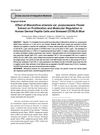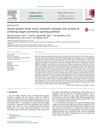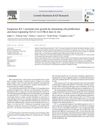TLDR Cyclosporin promotes hair growth by boosting cell growth and reducing cell death.
The study investigated the effects of cyclosporin A (CsA) on hair growth using a mouse vibrissae organ culture model. Results showed that CsA at a concentration of 10^-7 mol/L significantly increased hair shaft elongation and decreased catagen formation, indicating enhanced hair growth. CsA also stimulated the expression of the Ki67 antigen and reduced apoptosis in hair follicle cells. Additionally, CsA treatment led to higher mRNA levels of growth factors HGF, VEGF, and NGF, while reducing follistatin mRNA levels. These findings suggested that CsA promoted hair growth by stimulating cell proliferation and inhibiting apoptosis, with changes in specific growth factor expressions contributing to its effects.
9 citations
,
July 2021 in “Journal of Medicinal Food” Lactobacillus paracasei HY7015 helps hair grow in mice.
26 citations
,
December 2020 in “Genes” A combination of IGF-1 and EGF promotes hair growth in Angora rabbits.
10 citations
,
August 2020 in “Acta histochemica” All-trans-retinoic acid stops mink hair growth by affecting cell growth and causing cell death.
 15 citations
,
May 2020 in “BMC complementary medicine and therapies”
15 citations
,
May 2020 in “BMC complementary medicine and therapies” Polygonum multiflorum extract helps hair grow longer and fights the effects of hormones that cause hair loss.
 8 citations
,
June 2019 in “Journal of Ginseng Research”
8 citations
,
June 2019 in “Journal of Ginseng Research” Gintonin-enriched fraction promotes hair growth and could be a potential alopecia treatment.
 8 citations
,
May 2017 in “Chinese Journal of Integrative Medicine”
8 citations
,
May 2017 in “Chinese Journal of Integrative Medicine” Miscanthus sinensis flower extract may help promote hair growth and prevent hair loss.
 11 citations
,
October 2016 in “Biomedicine & Pharmacotherapy”
11 citations
,
October 2016 in “Biomedicine & Pharmacotherapy” Both human platelet lysate and minoxidil can promote hair growth, but they affect different genes and cell survival rates.
 53 citations
,
March 2014 in “Growth Hormone & IGF Research”
53 citations
,
March 2014 in “Growth Hormone & IGF Research” IGF-1 injections help mice grow more hair by increasing cell growth and blocking a hair growth inhibitor.
27 citations
,
December 2012 in “The Journal of Steroid Biochemistry and Molecular Biology” Dexamethasone may cause hair loss by stopping cell growth.




